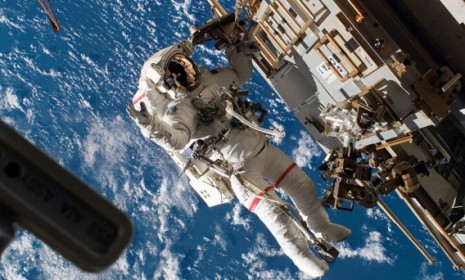What is NASA's '100-year starship'?
The government is working on a spaceship — expect a prototype within a few years — that would take astronauts on a one-way trip to Mars

NASA and the Pentagon's Defense Advanced Research Projects Agency (DARPA) are starting work on a "Hundred Year Starship" designed to take astronauts on a one-way trip to other planets, says NASA Ames Research Center director Simon "Pete" Worden. "You heard it here," he told a gathering in San Francisco last weekend. "The human space program is now really aimed at settling other worlds." What is the Hundred Year Starship, and will it make our sci-fi dreams a reality?
Why one-way space travel?
Keep in mind that space is "annoyingly, impractically huge," says Evan Dashevsky at GearLog, with the nearest planet 24 million miles away. That means "it takes a long time to get to the good stuff." Also, it will cost a lot less, since the major expense of any plan to travel to other worlds is bringing the astronauts home, say geologist Dirk Schulze-Makuch and physicist Paul Davies in the Journal of Cosmology. Hopefully, adds Dashevsky, this doesn't mean NASA and DARPA "know something that we don't about the future habitability of this planet."
The Week
Escape your echo chamber. Get the facts behind the news, plus analysis from multiple perspectives.

Sign up for The Week's Free Newsletters
From our morning news briefing to a weekly Good News Newsletter, get the best of The Week delivered directly to your inbox.
From our morning news briefing to a weekly Good News Newsletter, get the best of The Week delivered directly to your inbox.
How much money are we talking about?
To date, not very much. NASA has contributed $100,000 to the project, and DARPA has chipped in $1 million. "And that's recession money," Dashevsky says. Worden says Google co-founder Larry Page asked him how much it would cost to send people on a one-way trip to Mars, "and I told him $10 billion." Page, he says, responded, "Can you get it down to $1–2 billion?"
Who would volunteer for such a journey?
Any final "price tag does not include the inestimable cost of saying goodbye forever," notes Rebecca Boyle in Popular Science. But Schulze-Makuch and Davies — who argue for having astronauts set up a permanent base on Mars — say they get plenty of volunteers for a one-way mission. "It would really be little different from the first white settlers of the North American continent, who left Europe with little expectation of return," says Davies. Schulze-Makuch says he himself would go, once his young children are grown.
A free daily email with the biggest news stories of the day – and the best features from TheWeek.com
What about the Hundred Year Starship itself?
Neither Worden nor NASA gave any details, but Worden did say NASA is looking at electric and ground-based microwave thermal propulsion systems to boost the ship into space, rather than using heavy rocket fuel. "Within a few years we will see the first true prototype of a spaceship that will take us between worlds," he says. "I think we'll be on the moons of Mars by 2030 or so."
How would people survive on Mars, or another planet?
"I don't have the slightest idea," says Worden. But it might make more sense to modify humans, genetically if necessary, rather than "make an environment on Mars like Earth." Schulze-Makuch and Davies point out that Mars has deep, natural lava caves that, if they have ice, could serve as a water-providing shelter for colonists. Still, how you think about colonizing another world depends a lot on how you view this one, Worden says. "If you're a conservative, you worry about it killing us; if you're a liberal, you worry about us killing it."
Are there any practical, earthly implications for this project?
According to Wired, the powerful and extremely efficient propulsion system on the spacecraft could "revolutionize air transport, because it becomes very cheap and still goes 100 knots," he says. "The idea is that you could easily go to Hawaii overnight, for example … with a lot less fuel." And, of course, much lower carbon emissions — potentially extending the habitability of humanity's current cradle.
Sources: Popular Science, Shadowlocked, GearLog, ScienceDaily, Kurzweil, Wired
-
 Taps could run dry in drought-stricken Tehran
Taps could run dry in drought-stricken TehranUnder the Radar President warns that unless rationing eases water crisis, citizens may have to evacuate the capital
-
 Alaska faces earth-shaking loss as seismic monitoring stations shutter
Alaska faces earth-shaking loss as seismic monitoring stations shutterIN THE SPOTLIGHT NOAA cuts have left the western seaboard without a crucial resource to measure, understand and predict tsunamis
-
 10 great advent calendars for everyone (including the dog)
10 great advent calendars for everyone (including the dog)The Week Recommends Countdown with cocktails, jams and Legos